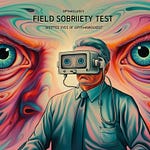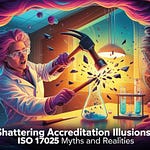When most people think of DNA evidence, they think of certainty. They think of “slam-dunk” proof that can put the right person behind bars or clear the innocent.
But what happens when the science itself goes off the rails?
In this week’s episode, I talk with Tiffany Roy, a forensic DNA expert, consultant, and founder of ForensicAid. Tiffany has spent her career examining the hidden flaws in DNA analysis and exposing systemic problems in how some public crime labs handle evidence.
Her recent critiques of the Minnesota Bureau of Criminal Apprehension (BCA), including their mishandling of complex DNA mixtures, have sent ripples through the forensic community.
Tiffany discusses landmark cases such as Minnesota v. Porter and Minnesota v. Bell, in which judges ruled that the BCA’s DNA evidence failed to meet scientific standards.
She also filed formal complaints with both the BCA and their accreditor, the ANSI National Accreditation Board (ANAB), and later with ANAB itself for failing to investigate her concerns in a timely manner.
Her findings reveal how flawed science can persist in the courtroom and how accountability, even in something as technical as DNA, often depends on individual experts speaking up.
Clips
Highlights
Poor understanding of validation and mixture interpretation has plagued the BCA DNA lab.
Significance of Minnesota v. Porter and Minnesota v. Bell, where judges excluded BCA DNA evidence for being scientifically unsound.
Roy discusses her 2021 complaints to the BCA and ANAB, including how the accreditor took nine months to notify the lab and later admitted her concerns were valid.
Outlines how the BCA’s leadership treats written procedures as “guidance,” violating accreditation norms.
Explains why forensic leaders resist criticism, citing a culture of self-protection and the Dunning-Kruger effect.
Calls for forensic commissions with real power and legislated depositions to promote transparency and accountability.
Links
Criminalistics: An Introduction to Forensic Science, 13th edition by Tiffany Roy
Forensic Science, An Introduction, 4th edition by Saferstein | Roy
Related Podcasts
Forensic Science Under the Microscope: A Look at Cognitive Bias
When Science Meets Justice: Fred Whitehurst’s Fight Against FBI Lab Misconduct
The Accuracy of Standardized Field Sobriety Testing (SFST) with Dr. Greg Kane
Challenging the Validity of SFSTs and Drug Recognition Testing with David Rosenbloom
Shattering Accreditation Illusions: ISO 17025 Myths and Realities
Automated Transcript (not checked for errors)
[00:00:00] Introduction and Guest Introduction
Aaron Olson: Hi everyone, and welcome back to the podcast. Today I’m talking with Tiffany Roy. Who is a forensic DNA expert and founder of Forensic Aid, where she helps attorneys and labs across the US and internationally understand the challenges of forensic evidence. Today we’re diving into what happens when DNA analysis goes wrong, how labs fall short, and what needs to change in the way of forensic science and how it’s used in the courtrooms.
Tiffany, thanks so much for coming on the podcast.
Tiffany Roy: Thank you for having me.
[00:00:28] Tiffany’s Background in Forensic DNA
Aaron Olson: So to start off with, tell me a little bit about yourself, uh, your background and how you got into forensic DNA analysis.
Tiffany Roy: I started my career in forensics at the Massachusetts State Police Crime Lab in their DNA unit. And, um, while I was there, I sort of realized that the culture within the laboratory, um, and, and just the.
The politics involved in, in working in a crime lab were just not for me. So about seven months after I began working there, I enrolled in law school and I started taking classes to become a lawyer at night. And I did that throughout my entire tenure at Massachusetts State Police. I graduated from law school in 2010 and took the bar.
And in that time, um. I took a job at a private laboratory in Deerfield Beach, Florida that tested evidence mainly for government crime labs and police departments called DNA Labs International. Um, so I, so I tested evidence, um, at both Massachusetts and DNA Labs International, and I wrote reports about my findings and I testified to those findings in court and.
Sometime in 2013, I left DNA Labs International at the end of that year and began consulting. So I, I taught at a few local colleges. There are some colleges online, um, classes in the area of forensics and law. And then I began to review cases for criminal defense attorneys mainly, and, um, examined.
Evidence from a wide swath of public laboratories, public and private laboratories from around the us and began to realize that not everybody is doing things, uh, the same or not. Everybody’s doing things well and not everyone’s doing things correctly. So that’s how I came to be in the position I am now.
Um, and, and that’s primarily the work that I do.
Aaron Olson: So tell me about more about that. So you found out that not everyone was doing things correctly.
[00:02:41] Issues in Forensic DNA Analysis
Aaron Olson: Uh, lately you’ve been posting things on LinkedIn and, and specifically you said that the Minnesota BCA DNA, uh, they’re not doing things, uh, as you would expect.
Tell me more about what’s going on there. So,
Tiffany Roy: I’ve worked with some really great, um, defense attorneys in Minnesota, and I first became involved in doing. Case work. They’re reviewing cases from that laboratory sometime around 2020. Um, I submitted my first complaint regarding the laboratory processes in 2021.
So that went to the Minnesota BCA QA department first, and then, um, they had their. They have to perform their investigation. Um, and then if I don’t find their investigation satisfactory, then I can escalate it up to to A NAB, and that’s what I did.
[00:03:35] Problems at Minnesota BCA Lab
Tiffany Roy: So essentially the problems in Minnesota at their crime lab, um, deal with complex mixtures, which is not a problem isolated to this particular laboratory, but it is particularly egregious at this laboratory.
What. The problem entails is that when we’re interpreting complex data from a DNA profile where there are mixtures of more than two people, um, and varying amounts of DNA, it’s very, very difficult to identify which parts and pieces in the DNA profile could come from a single contributor. And there are many laboratories in the United States that have had problems with this and that have been doing things not correct.
We as a field have implemented some tools that were designed to try to standardize these processes. But essentially the BCA lab had a problem always with not understanding the concept of validation and why validation is important, and why validation sets the perimeters for your standard operating procedures and how you operate within the confines of your validation.
So they had this problem when. They were manually interpreting mixed DNA profiles, complex mixtures. And, um, we’ve implemented some computer programs that have been designed to try to make some of the assessments, um, in a more uniform way. And BCA continues to struggle and, and. Operate outside of their own standard operating procedures and outside of their own validation.
So these problems have persisted there for a significant amount of time. There have been many independent DNA experts that have come through and reviewed cases from the Minnesota BCA that have excellent credentials and who are very experienced and proficient outside of myself that have identified similar problems, but the laboratories cannot be convinced that.
It needs to address some of the interpretation issues that it has with its mixture procedures. So I’m not the first to address this laboratory, and I’m certain I won’t be the last. And there have been a number of excellent lawyers and excellent forensic DNA analysts who have tried to help the laboratory to get, um, in line with standard and best practice.
And we’ve been unsuccessful to this point in doing that. Through the scientific process.
[00:06:02] Legal and Accreditation Challenges
Tiffany Roy: So laboratory quality assurance systems and accreditation lab, forensic laboratory accreditation. And at this point, we’re having success, more success now in the court system and having the evidence excluded than we are.
Ha, you know, effectuating the. The oversight, the forensic oversight that we have to step in and make necessary changes. So that’s, that’s how we came to be at the point that we’re at.
Aaron Olson: And you mentioned that you had recently heard some more news from A NAB. Can you share more about what happened or what’s going on there?
Tiffany Roy: So, uh, I have several cases that are pending, um, litigation on. For exclusion from court proceedings, and I’m aware of a number of cases that have just been excluded and the judge’s rulings are scathing. Uh, essentially they’re the findings and the, the main cases. Um. That have identified these problems.
[00:07:04] Case Studies and Court Rulings
Tiffany Roy: One is Minnesota v Porter, and that was heard before. Uh, judge Pam King, who is very active in the forensic community, knows what she’s talking about, understands the concepts of validation. Um, and the expert in that case was Cynthia Kale, who is a close colleague of mine. I rely on her for, uh, like as a sounding board.
And consultation. Um, and the lawyer involved with that, the defense attorney was, um, JD Schmidt, who was also exceptionally proficient in identifying problems and understanding forensic DNA. So that was really the first case to, um. To have the evidence successfully excluded for failure to adhere to the validations and their own standard operating procedures and interpretation of the DNA profiles in that case.
And there was a second case, um, that where the evidence was just excluded on very similar grounds, and this also involves Cynthia Kale, but this was, um, defense attorney involved in this was Sarah Prentice Mott, and this case is Minnesota VI Bell. So these cases all have very similar issues. I have several cases with, um, with attorney Mott Prentice Mott, and I just received another case that’s also very egregious.
So the more cases that stream past me, um, and the, the, the longer I see these problems persist, I. It triggers me to wanna reach out again to the accrediting body and ask them to become involved. It’s obvious that the BT A is having problems in some other areas of forensic science, but I approached the laboratory and a and a B about their failure to do these things that are the subject of these most recent court rulings, you know, four, four years ago.
And. I submitted a formal written complaint to both the laboratory and A NAB, um, the laboratory. It took them, I think, more than a year to investigate and formally respond, which in order to escalate this up to a, a b to the crediting body, um, the laboratory, they require you to submit the complaint directly to the laboratory quality management system to allow the lab the time that.
It needs to investigate and see if they can deal with the problem on their own. If they can identify it and, and implement corrected measures, um, that, that the accrediting body finds sufficient, then there’s no need to escalate it up to the accrediting body. But that’s not what happened. I submitted my complaint to the BCA.
They did their investigation and told me that they felt my concerns were without merit, and then I escalated that up to. In 2021, um, A NAB. I had cases continuing to come through the BCA, and I was working on one particular case with attorney JD Schmidt, and I mentioned to him that I had written this complaint.
What is the status of this complaint? Let’s do some legal discovery to find out what investigation is taking place, what is happening at A and a B? What documentation can we get from them about what my concerns are and how those are being investigated? And. JD Schmidt made a public records request to the laboratory for any communication from A NAB regarding the substance of my complaint that I had lodged with them, which they had accepted, acknowledged that I had all the proper paperwork, and, um, essentially promised to investigate timely, and A NAB sat on that complaint and never even notified the laboratory of its existence for nine months.
So when he reached out for the communication between the accrediting body in the lab, there was none. And, um, that triggered me to file a complaint against the accrediting body itself for failure to investigate timely. So all of that time, a year plus of bad cases while they, while the laboratory tried to identify my concerns to them.
And then nine months of failed investigation for A and a B, we’re talking about two years. These concerns were expressed and not addressed because the forensic accreditation process requires these initial steps to take place. And because they failed to even attempt even notify the laboratory that I had concerns that I escalated to them.
Um. And so I filed a complaint against the accrediting body and they found, so they had to investigate themselves now at this point for failure to investigate, and they found that my concerns had merit. So A and a B themselves admitted that what took place in this particular instance was unsatisfactory and problematic.
I mean, if we submitted, if a victim went into a police station and reported a sexual assault and the police department took nine months to investigate it, we would be outraged by that. That would be professional negligence. And I feel like that was professional negligence in the instance of my complaint about the BCA.
And A NAB agreed with me, but they never told me what remedial measures would be taken to ensure this didn’t happen again in the future. They never provided to me any information about, um, what their investigation into my concerns about them entailed my concerns about the BCA entailed. Um, I did receive two closures of.
Complaints, one page closures, um, for findings, saying that they didn’t believe that my concerns about the VCA had any merit. And I got an, and it was another closure on the same day, um, which looked to me like they were just trying to get rid of me and clear the docket, um, without really looking into any of the concerns I had expressed.
So when I received another bad case last week, I. Resubmitted all this paperwork to them again and essentially stated, you know, now we have this Porter decision and now we have this bell decision where two different judges in Minnesota and. Two different lawyers on different cases identified the same issues that I expressed to ‘em in 2021.
The problems are still persisting, even though they found that my concerns didn’t have merit. These judges have now found that my concerns have merit because these, this is still happening at B-C-A-D-N-A lab. And I asked them to go in there with an expert, a qualified expert, and I mentioned two people’s names, um, and examine at least the two cases that have been excluded from use in court and see if the problems of.
Failure to adhere to your validation and failure of you to adhere to your SOPs, which flow from your validation. And they sent me back communication today that I need to submit a new quality assurance complaint to the Minnesota BCA before A and a B will accept my most recent complaint. And so the process begins again.
And bad cases flow into our court system for judges that are not as sophisticated as the judges in the two cases I mentioned and. I read and reread the requirements from A and a B, and I have fulfilled the requirements as they’re written. There is no re requirement that I submit a new complaint to reiterate my same concerns, and I’m going to address that with them.
But I know that I. I’m not gonna waste any time before I submit complaints to BCA to get that process started for them to investigate what happened in Porter and what happened in Bell. Because if these judges can identify that there’s a problem through testimony and legal presentation by lay lawyers.
Then this laboratory should absolutely be able to identify the problems identified by these judges and figure out whether this is systemic, because I know it’s systemic. Um, and, and aside from this is that I, I feel that. The BCA. Once these cases were excluded by judges based on scientific basis, the laboratory themselves should have opened a quality investigation into what happened and why the judges must have felt the way they felt.
Um, you know, they had clear violations, clear instances of them not following their procedures, which they de describe in testimony as guidance. Which Pam King rejected. Um, you know, these rulings and these transcripts contain information that the judges relied on to say you’re not following your own rules that you set for yourself, and that should be giant accreditation concern.
And it should be a giant laboratory concern. You know, these aren’t just guidelines. These are hard and fast rules, and if you’re gonna depart from them, you better have a good damn reason why. And they just don’t, they don’t feel like they need to do that. And the, the individual who runs the laboratory, her name is Marilyn Horn.
She cannot be convinced that you know, that these people need to do this in a consistent way. That they need to adhere to their standard operating procedures very closely and that their standard operating procedures flow from the data in their validation. So if you have a case where there’s a profile that doesn’t look anything like the profiles you tested in your validation, you shouldn’t be interpreting it.
Um, and she doesn’t understand that as a fundamental concept that the validation is vitally important and you have to operate within the confines of your validation. And so that’s a giant problem where the problems roll downhill. We’ll say it starts at the top. Um, and, and so the technical leadership at that laboratory.
Is flawed and problematic, and the only thing that’s gonna help at this point is for the accrediting body to force change because scientifically, there have been many voices, critical voices of the work that’s been coming out of that laboratory and. They’ve been ignored, largely ignored and, and minimized.
Um, I’ve, in responses to reports that I’ve written, I see that Caroline Hor reduces my, my qualifications and my experience in the field to the four years that I spent at a publicly funded government crime lab. And, you know, it’s, it’s, that is gonna continue to happen with everyone who’s critical. Of the work that’s coming out of that lab.
And so somebody with, you know, some authority has to step in there to stop what’s happening.
Aaron Olson: Yeah. Yeah. Why do you think there is such pushback on, uh, outside criticism or, uh, you know, critique of something instead of trying to do better?
[00:19:14] Systemic Issues and Human Factors
Aaron Olson: There’s, there’s almost, uh, the opposite reaction of, of, you know, we’re the good guys, you’re the bad guys, and this is, this is how it’s done.
I think that comes from,
Tiffany Roy: that comes from human factors. This is just a real, this is mental at this point. Right. And I think it’s done in Kruger, if I’m being honest, because admitting that there is a systematic problem is devastation to these people, to their interests, to their livelihood, and also. DNA is very powerful and to think that under your watch there could be hundreds of thousands of cases that were flawed, where people could be convicted wrongfully be for your failure to lead and to ensure technical accuracy.
That’s something that people are un judges are unwilling to accept that, um, that their rulings could be based on flawed science and they don’t wanna overturn convictions based on this stuff. These people have. Real interest skin in the game and admitting the problem is adverse to their own personal interests and they’re smart, right?
I would never say that I think Marilyn Hoen Dorn is stupid, but it is a very difficult task to admit, an extremely egregious mistake, and that’s what’s occurring at Minnesota BCA. These are just human people that run these labs and they’re susceptible to all of these cognitive. You know,
interactions, we’ll call ‘em, I don’t wanna call ‘em biases, you know, but there’s a lot of cognitive science that goes into leadership in situations like this. People who run hospitals, the people who run Boeing, um, these are, these are things that we’ve observed, you know, in these leadership roles and other areas.
Surgeons, you know, um, but they’re just regular human people and trying to. Wrap your head around a very serious errors is something that it’s averse to their own human interests. Like I have, um, a case, a really serious case that involves microscopic hair analysis and an expert from the FBI Overstated the microscopic hair analysis with no forensic DNA testing four times in four separate trials.
And in the end, in the fourth trial, the only evidence that existed physical evidence was this overstated hair comparison. Um, and this expert from the FBI who no longer works there, but he works. He works at George Mason University, seems Joseph Dino. And in this death row case, he continues to defend language in all four trials and the FBI themselves.
Investigated these transcripts and sent to Brady notification stating that they identified in the report and all four trials over statements, and he still continues, even though it was his own colleagues that identified this problem and stated it was problematic and notified the lawyers involved. He still maintains that he believes that what he said was appropriate because he could be sued.
If he admits that there was a problem, um, even in the face of all that evidence, even in the face of his own colleagues telling him, this is a problem, you’ll not admit it. And he’s positioned at George Mason teaching forensic science students now, still today. And this client, Gerald Murray, is on death row.
Florida, the state of Florida seeks to execute him based only on the flawed words of Joseph Dino. And I can’t wrap my brain around it, but I’ve never been faced with something that serious that, you know, I would need to protect my own human brain from dealing with that understanding that I, that I did something that caused something like that.
Aaron Olson: Yeah. Yeah. So what’s the path forward?
[00:23:25] Advocating for Forensic Oversight
Aaron Olson: Where do we go from here?
Tiffany Roy: I advocate on every platform that I’ve ever been given for real meaningful forensic oversight, like in, in the likeness of the Texas Commission on Forensic Science. And, and those state commissions are not perfect. Um, but the closest thing we have to a model for real meaningful forensic oversight that will.
Be able to address issues like this are oversight bodies that have qualified forensic scientists and lawyers and other criminal justice stakeholders on them that have statutory power to step in and address a problem, a scientific problem from a scientific perspective, such that the scientists don’t have to convince a lay judge through a lay lawyer.
That there’s a real scientific problem. It’s just scientist to scientist. I make my case, I would win a lot more than I do in court because I’d be, they’d be evaluating the science itself instead of the makeup on my face. Or, you know, the fact that I’ve been in private practice, you know, for half of my career and not in the government crime lab, you know, as a prosecution witness.
So there’s a lot of things that go into courtroom presentation that would. Wouldn’t play a factor in, you know, the gatekeeping if we had real meaningful forensic oversight. And we can’t wait any longer for that. And I think we need it at the state level. Every single state should be reaching out to the Texas Commission and looking at the language and the laws to implement that.
Um, there’s no absolutely no reason. I live in the state of Florida and I practice in the state of Florida. A great deal and nail technicians that perform my French manicure have more oversight and regulation than the DNA experts that are interpreting evidence and testifying In cases where this state seeks to execute those defendants, we kill people in Florida at a breakneck pace.
More than any other state we’re exercising capital punishment. That’s a very real thing here, and there’s absolutely no oversight of these forensic scientists except for A NAB, and I’ve just described how effective that process is for affecting real change. And I have complained about laboratories here in Florida, and I have escalated those up to A and a B, and they have stepped in and helped in the past.
They don’t always ignore me, but. I practice at a high level, and unless there’s somebody being retained by A NAB, that’s not Bradford Putnam, you know, that has real expertise in forensic DNA, they’re gonna miss these things that I’m describing. Marilyn Hoor is missing it and she. Is smart and has specific training in this area.
So how is Bradford Putnam, who I don’t even know, what kind of training and expertise he has, how is he going to investigate something so scientifically complex that I’m saying this whole laboratory full of people isn’t getting it, but A NAB is gonna get it. Like that’s, this is, it’s not, it’s, it’s no one guarding the hen house.
It’s like. A hen guarding a hen house and mm-hmm. And they can’t, we cannot self-police. So oversight bodies and commissions, these are absolutely necessary. And another thing I advocate for staunchly is. Deposition in criminal cases, and that needs to be legislated. Um, in Florida, we have mi It’s part of routine criminal discovery that we get to depose experts, um, in advance of trial and in so many of these cases.
This stuff is readily discoverable Li listening to the testimony. Right? So the testimony that was presented to Pam King, if we had an opportunity to go before her, her, and have this expert acknowledge Yes, I, I didn’t follow the procedures here. Yes, I didn’t follow the procedures there. These, these lawyers in Minnesota would.
Would be able to, with the help of another, you know, another expert, identify these issues and then have the testimonial evidence to go to a hearing and say, Hey, look, this should be excluded. We don’t, you know, they, they get that ammunition before they start the Daubert process. So a lot of the problems, many of the problems I see in forensic DNA deal with overstatements or misstatements and, um.
Deposition helps me to identify the scientists who know what they’re talking about and make sure that the evidence that’s gonna come in on the record, right? Because our reports don’t come in on the record, nine times outta 10. They’re hearsay. So. The expert describing their results and their opinions.
That’s the evidence. And that evidence needs to be scrutinized before it’s ever presented to the jury to make sure it’s as good as it can be, and to litigate these issues before it comes, before the people who are gonna be the legal decision makers. So oversight, real meaningful oversight at the state and federal level, and deposition of experts in criminal cases.
Aaron Olson: Yeah.
[00:29:02] Conclusion and Final Thoughts
Aaron Olson: Well, Tiffany, I appreciate you taking time outta your day to come on the podcast. Do you have any final thoughts that you wanna leave listeners with before we end the call?
Tiffany Roy: Um, no, I think I’ve said, I’ve said enough.
Aaron Olson: I appreciate it so much. Thanks for coming on the podcast today.
Tiffany Roy: No, thanks for having me.












